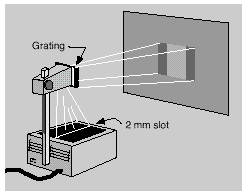
3. Darken the room and turn on the projector. Using tape, hang a piece of holographic diffraction grating over the upper lens of the projector. Before taping, rotate the grating until the best spectra is displayed. Two brilliant visible spectra appear on opposite sides of a line running from the projector perpendicular to the screen. The size of the display can be changed by moving the projector closer or farther away from the screen. Refer to the Analytical Spectroscope activity for more information on how the diffraction grating works.
Discussion:
Visible light, passing through a prism at a suitable angle, is dispersed into its component colors. This happens because of refraction. When visible light waves cross an interface between two media of different densities (such as from air into glass) at an angle other than 90 degrees, the light waves are bent (refracted). Different wavelengths
- Use crayons or colored pencils to sketch the spectra displayed by either projection method. What colors are visible?
- Who discovered the visible spectrum? How many colors did the scientist see?
- A compact audio disk acts like a reflection diffraction grating. Darken the room and shine a strong beam of white light from a flashlight on the disk. The beam will be dispersed by the grating and be visible on a wall.
Arbor Scientific
Flinn Scientific
Learning Technologies, Inc.
P.O. Box 2750
Ann Arbor, MI 48106-2750
Phone: 1-800-367-6695
P.O. Box 219
131 Flinn Street
Batavia, IL 60510
Phone: 1-800-452-1261
59 Walden Street
Cambridge, MA 02140
Phone: 1-800-537-8703.
